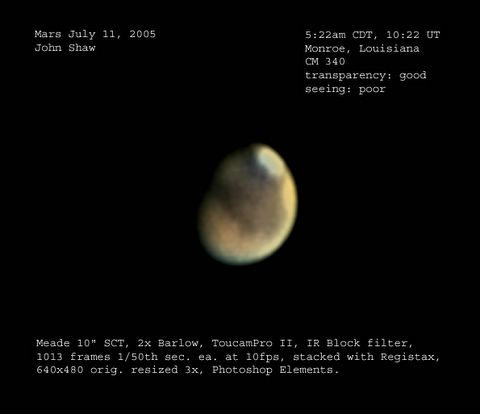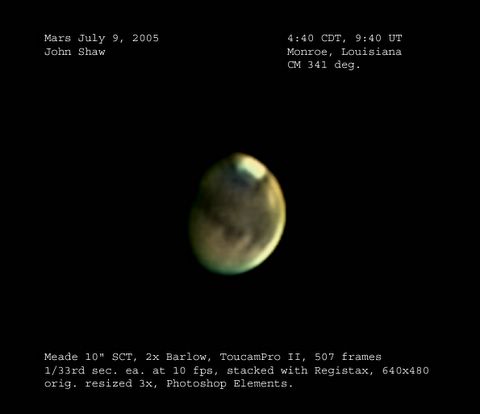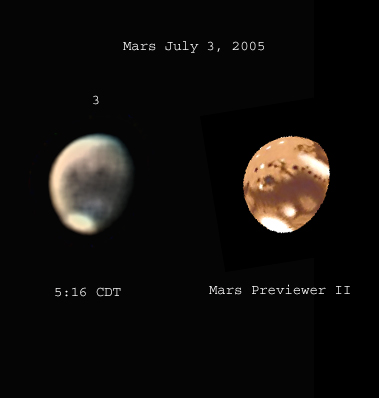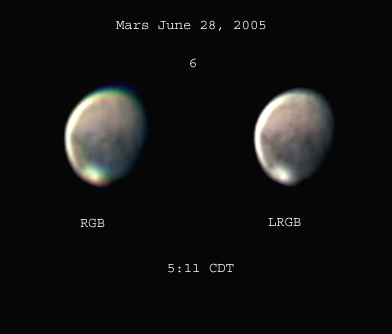Monday, July 11, 2005
Sunday, July 10, 2005

Mars July 10, 2005. We drove to Covington near new Orleans and back to pick up Hollin so I just had time to set up the telescope and grab two sequences after arriving home at 5am. This is nearly the same central meridian as the July 9 image and it is a shorter run -- not enough frames to get a really smooth image. It was, however, the first sequence since the arrival of the Baader IR block filter. The filter seems to help the sharpness of each frame, but I need to get more frames next time.
The sky in Covington was gorgeous. There were 6th magnitude stars visible from a site just on the edge of town. The milky way was clearly visible with a good view of the star cloud around the North American nebula. I expect I could easily see the North American if I had a n LPR filter.

Saturday, July 09, 2005
Thursday, July 07, 2005

I got up to really nice seeing this morning. Surprise! The tropical storm south of here has given us some rapid changes in weather. I had been having bad seeing early in the morning and would have to wait to about 5:30am to get any brief windows of steadiness. This time the seeing was very steady with small ripples and undulations early on, about 4 am, then got worse as some clouds blew through and by 5:30 it was fair at best.
Sinus Meridiani and Sinus Sabaeus are now visible, but not as distinct from regions to the south as I remember from 1988. I'm sorry to say I missed 2003.

Wednesday, July 06, 2005
Tuesday, July 05, 2005

These are the red, green, and blue channel images separated with Iris. I thought it was interesting that the blue haze over Argyre really doesn't show up in the red and green channels at all. I expected the polar cap to blur more or less the same way in all channels if the haze were just a blurred double image of the polar cap due to seeing. Hmm. I don't know.


I spent the day fighting Registax and ended up using Iris to get rid of some fixed-pattern noise and do the RGB separation and recombination. I found a good site for determining the seeing. Damian Peach has animations of stellar diffraction disks and the equivalent Pickering scale value. here .

Monday, July 04, 2005

Mars July 4, 2005. Taken 5:44am CDT. This is processed from the same sequence as the RGB image below. I experimented with the LRGB settings and tried to keep the processing more "natural" looking. Upsizing the image seemed to help my eye see lower contrast details so I could back off the agressive wavelet settings. There is some tradeoff in sharpness, but I'll keep experimenting with this. I switched to south-up, after finally getting myself used to north-up images, since this was sent to the mars observer group in Yahoo and they are using the south-up standard.

Sunday, July 03, 2005

Ok, here is a comparison of processing a video sequence in Registax to get an RGB image vs. the same sequence processed to get an LRGB image. Hmm. Interesting. Aurorae Sinus looks like a giant tarantula. Shades of Ziggy Stardust! Clearly the LRGB shows the albedo features better. However, I like the color on the RGB better. I wonder if I can figure out how to get the best of both?


Mars July 3, 2005. Taken at 5:13am CDT. High altitude clouds moved in before I had a chance to do many focus runs. Yesterday and today I was shooting through gaps in the cirrus cloud coverage. This is LRGB processed in Registax instead of RGB processed. I deemphasized the blue channel and emphasized the red and green channels using the channel mixer. The bluish halo around the polar cap is eliminated. The haze over Argyre, a real feature, was visibly darkened. The image is soft and I had to get agressive with the wavelets to see much. This is about 400 frames stacked out of 1000 frames captured at 10 fps.

Saturday, July 02, 2005

Mars July 2, 2005. Taken 5:40am CDT. Solis Lacus now left of central meridian and the dark area closer to the terminator must be Aurorae Sinus. I think the white spot to the left of Aurorae Sinus is the region called Ophir/Candor on the BAA chart. I finally got Mars Previewer II to install under windows XP, so that eliminates some of the mental gymnastics aligning a flat Mercator chart to the view on a tilted and curved planet. Not sure why the installer failed during multiple attempts earlier.

Friday, July 01, 2005

Mars, July 1, 2005. 5:40am CDT. Despite getting up early to see other parts of Mars, the best seeing has been around twilight. The central meridian longitude on Mars for this image is 74 degrees, i.e. the center of the disk is longitude 74. The phase means that the center is about 2/3 of the way from the limb and 1/3 of the way from the terminator so just to the right of the darkest feature. The details visible are tantalizing. They seem almost distinct, but at the same time on the edge of dissolving away. I'm not 100% sure of the albedo differences to expect between the classical features of Mars. The charts of Mars help, but sometimes contradict each other or are too stylized to be of use. Meridian and Starry Night are computer programs that show the phase and markings, but I've found useless--Meridian is too stylized and cartoonish, Starry Night shows an artist's airbrushed version that emphasizes the surface features seen by orbiters and not what a telescope from earth sees. Hmm. I think the darkest spot is Solis Lacus. I misidentified it earlier and thought it was Aurorae Sinus, but I was wrong. I made a mistake judging the image scale and the albedo from the charts. There is a useful tool at Sky and Telescope for determining the part of Mars facing earth at any given date, here. Unfortunately it doesn't have phase and tilt and matching the mercator projection to the image requires an act of imagination. The best charts seem to be at the BAA site here. I like the Ebisawa charts best. I'm putting a small crop of the Ebisawa chart below for reference.


Ebisawa map segment showing the features I've identified from Sirenum to Solis Lacus. Add the south polar cap along the bottom, realize that the Mars is tilted so the north part of the map is cut off on the photos, and you can start to line up features. This map seems to be the best fit to the albedos I get from the webcam.









